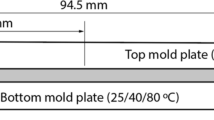Abstract
The stress state of the surface layer of a polymeric mass during filling of bulky compression molds is analyzed. It is shown that, at particular rheological characteristics of the mass, temperature, and filling rates, cracking of the surface layer occurs, which leads to defects in the finished products. A physical analysis of this process makes it possible to conclude that the cracks arise due to the normal stresses operating in the front region of the moving polymeric mass. It is found that, under certain flow conditions, areas with a pressure lower than the atmospheric one appear on the surface of the polymer. If the tensile stresses arising in these local regions are higher than the tensile strength of the mass, the continuity of the composition is broken in the direction determined by the greatest rate of the normal deformation. To confirm the reliability of the crack-formation mechanism proposed, the distribution of the pressure and normal stresses over the free surface is calculated based on a numerical method. These calculations show that, by comparing the stress level achieved in the front region with the tensile-strength characteristics of the polymeric composition, it is possible to predict, with a sufficient accuracy, the possibility of crack formation in the surface layer of such a mass under given flow conditions and thus to solve the question on flawless manufacturing of products.
Similar content being viewed by others
References
D. Cornfeld, Elasticity and Strength of Liquids [in Russian], MoscowûLeningrad (1951).
M. Reiner, Deformation, Strain, and Flow, H. K. Lewis & Co. Ltd, London (1960).
S. Middleman, Flow of High Polymers, Interscience Publishers, A Division of John Wiley & Sons, New YorkûLondonûSydneyûToronto (1968).
G. R. Shrager, A. N. Kozlobrodov, and V. A. Yakutenok, Modeling of Hydrodynamic Processes in Processing Technology of Polymeric Materials [in Russian], Izd. Tomsk. Univ., Tomsk (1999).
L. I. Sedov, Continuum Mechanics. Vol. II [in Russian], Nauka, Moscow (1973).
G. K. Batchelor, Introduction to Fluid Dynamics, Cambridge University Press (1970).
V. P. Ishchenko and A. N. Kozlobrodov, “Filling of vertical cylindrical channels with a non-Newtonian fluid,” Izv. Sib. Otdel. Akad. Nauk SSSR. Ser. Tekh. Nauk, No. 10, Iss. 2, 34-42 (1985).
Z. P. Shul'man, Convective Heat and Mass Transfer of a Rheologically Complex Fluid [in Russian], Nauka i Tekhnika, Minsk (1975).
A. Ya. Malkin, A. N. Kozlobrodov, and V. P. Ishchenko, “Measurement of the strength of highly filled polymers in a viscofluid state,” in: Problems of Aerohydromechanics and Heat and Mass Exchange in Some Technological Processes [in Russian], Izd. Tomsk. Gos. Univ., Tomsk (1979), pp. 49-54.
A. N. Kozlobrodov, “Flow of a nonlinear viscoplastic fluid in cylindrical channels,” in: Problems of Hydromechanics and Heat and Mass Exchange [in Russian], Izd. Tomsk. Gos. Univ., Tomsk (1986), pp. 31-37.
Author information
Authors and Affiliations
Rights and permissions
About this article
Cite this article
Kozlobrodov, A.N., Shrager, G.R. Analysis of the Stress State of the Surface Layer of a Polymeric Mass upon Filling of Bulky Compression Molds. Mechanics of Composite Materials 37, 357–364 (2001). https://doi.org/10.1023/A:1012349021266
Issue Date:
DOI: https://doi.org/10.1023/A:1012349021266




